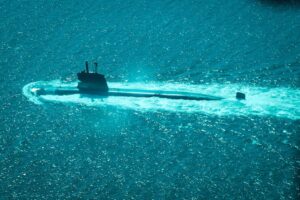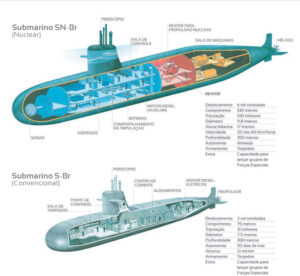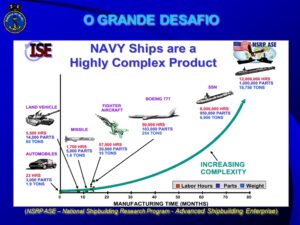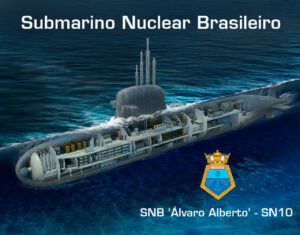Marinha do Brasil: "S-40 Riachuelo" put into service
On 1 September 2022, the Brazilian Navy put the "S-40 Riachuelo" submarine into service. The unit is the first of four new submarines with conventional propulsion (NATO classification SSK). When it was launched in December 2018, it was expected to enter service in 2020. Construction number 2, S-41 Humaitá, carried out an initial functional test on the day before the ceremony for the type ship.
Brazilian-French co-operation
As part of a Brazilian-French defence cooperation, Brasilia decided to launch the PROSUB programme, Programa de Desenvolvimento de Submarinos, in 2009. The programme provides for the reinforcement of the submarine flotilla with four conventional and one nuclear-powered submarine. The programme also provides for the construction of a shipyard and a submarine base for the construction and support of these units.
While parts of the S-40 Riachuelo were manufactured in France, the three other Scorpène BR boats are being built entirely by the Brazilian company Itaguaí Construções Navais (ICN). The state-owned company, in which the French Naval Group holds a 41 per cent stake, employs almost 2,000 Brazilian workers. In addition to the few French people working on site (a company brochure puts the number at 15), the Naval Group also claims that "hundreds of employees" work in the back office for PROSUB at its French sites.

PROSUB: More than just submarines
Acquiring the industrial and conceptual capabilities required for the development and construction of its future nuclear-powered submarine is extremely important for Brazil. On the government's website, the PROSUB submarine development programme is described as one of the most important strategic projects of the Brazilian armed forces. It is intended not only to strengthen the national defence structure, but also to guarantee "Brazilian maritime sovereignty". In addition, the programme strengthens the industrial base, thereby contributing to the country's economic development. According to government figures, 4,000 jobs have been created to date.
PROSUB goes beyond conventional submarines. In connection with the Navy's nuclear programme (Programa Nuclear da Marinha, PNM), Brasilia is pursuing the construction of Brazil's first nuclear-powered submarine, Submarino de Propulsão Nuclear Brasileiro (SNBR). In the Defence White Paper 2020, the government points out that the two programmes are linked. It states: "The feasibility of PROSUB depends on the development of the nuclear propulsion system, which is at the heart of the Navy's nuclear programme." Among other things, the PNM provides for the development and construction of a prototype pressurised water reactor, which is intended as the basis for the reactor of Brazil's first nuclear-powered submarine.
As part of PROSUB, a naval shipbuilding complex for the construction, operation and maintenance of conventional and nuclear submarines was built near Itaguaí (75 kilometres west of Rio de Janeiro, 895 km south-east of the capital Brasília). The Madeira naval base, which now also houses the headquarters of Itaguaí Construções Navais, was inaugurated in 2020. In July 2021, the Brazilian submarine commander (ComForS) relocated to Itaguaí/Madeira.

Scorpène-BR
The "S-40 Riachuelo" has an overall length of 70.62 metres, a hull diameter of 6.2 metres, a displacement of 1,740 tonnes on the surface and 1,900 tonnes submerged. It has six weapon launchers. The armament includes the French F21 heavyweight torpedo, MM39 anti-ship missiles and mines. According to the Naval Group, the Brazilian variant can carry a total of 18 missiles and/or torpedoes. The Brazilian Navy uses SUBTICS from Naval Group as its command and weapon deployment system. The boats are to be designed for a crew of 35 with the option of carrying twelve additional people. Four diesel engines and four generators ensure propulsion and power supply. The maximum speed is specified at 20 knots.

In Brazil, the boats are also known as Scorpene-BR or S-BR. They are based on the French design of the Scorpène 2000. This is a conventional submarine with a displacement of around 2,000 tonnes. The hull varies between 66 and 82 metres. Features include an air-independent propulsion system, a high degree of automation, various equipment options and the ability to accommodate crews of 25 to 31 people.
A total of 14 Scorpène are under contract or already in service worldwide. Two each are in service in Chile and Malaysia, and four in India. Two more are awaiting completion there. With the "S-40 Riachuelo", the group of operational Scorpène 2000s has expanded to nine boats.
Construction of the remaining boats has started in Brazil, with "S-42 Tonelero" starting in 2017 and "S-43 Angostura" in 2018. Naval Group has set 2025 as the delivery date for the last boat. The total cost is estimated at 10 billion US dollars. There are contradictory statements about the future of the existing U 209 series submarines.

The end result is a nuclear submarine
The nuclear submarine "SN-10 Álvaro Alberto" is presumably nearing the end of the 'initial design phase'. According to the website of the Brazilian Ministry of Defence, its sea trials are currently scheduled to begin in 2029. As of 2020, the estimated costs for development and construction amount to over 7.4 billion US dollars. According to older Brazilian press reports, the country is planning six units of this class by 2047. Brazilian terminology refers to the SN-BR. It is expected to be around 100 metres long with a diameter of 9.8 metres, which would give the SSN a displacement of around 6,000 tonnes. This would make it somewhat heavier than its French Suffren-class cousin. This means that the French Barracuda project, to which the Suffren class belongs, still has a happy ending despite the Australian withdrawal.
The "S-40 Riachuelo" is the seventh unit of the Brazilian Navy and the third submarine to bear this name. In the Battle of Riachuelo in 1865, the navies of Brazil and Paraguay faced each other on the Paraná River. Brazil won the conflict. The battle is considered a decisive turning point in the Triple Alliance War from 1864 to 1870 - Brazil, Argentina and ultimately Uruguay faced off against Paraguay.
+++++








